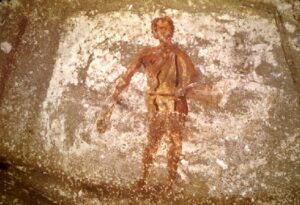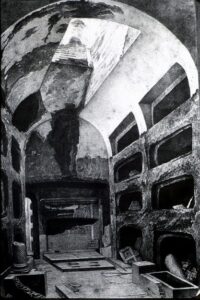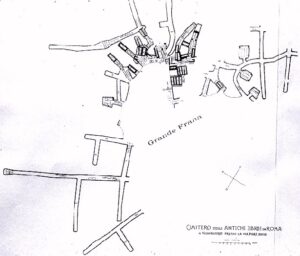Excerpt from: Estelle Shohet Brettman, Vaults of Memory: The Roman Jewish Catacombs and their Context in the Ancient Mediterranean World, with Amy K. Hirschfeld, Florence Wolsky, & Jessica Dello Russo. Boston: International Catacomb Society, 1991-2017 (rev. ed., 2024).
Most present-day scholars concur with archaeologist Giovanni Battista de Rossi that the Jewish and Christian catacombs developed synchronously as part of a Late Antique burial trend "not confined to the adherence of one religion only".[i] This would place the creation of catacombs in Rome within the overall chronological framework of the third to fifth centuries CE.[ii]
In a general shift from cremation to inhumation in Rome in late first century CE, masonry tombs built aboveground began to replace columbaria. The Jewish and Christian communities were both growing in size, with the consequent necessity to find more burial space.[iii] The pagan population also felt the pressure for space as the compact columbaria containing multiple burials were succeeded by the spread of larger sub-surface graves and masonry tombs.
The Jewish and Christian communities had by now formed distinct congregations and even possibly collegia funeraticia, no doubt with prosperous members among them. These groups set about buying properties outside the city walls where they could establish cemeteries for co-religionists in areas indisputably their own. As Rutgers observed, "in death, both Jews and Christians wished to preserve their respective communal identities." They felt an obligation also to insure that even the poorest among them would be provided with a proper burial among their brethren.[iv]
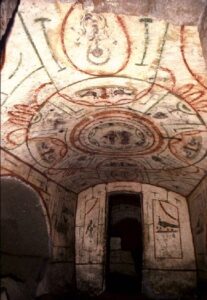
Fig. 1. Paintings in the "Double Chamber" of the Catacomb of Vigna Randanini in Rome, which was intercepted by subsequent digging to enlarge the underground Jewish cemetery (DAPICS n. 0139).
Toward the end of the second century CE, many of the tombs could not accommodate any more burials. A practical way to create more space was by digging down into the earth beneath these sites, or by carving out additional chambers from the existing hypogaea to develop and enlarge the underground burial area. As subterranean excavations continued, diggers began to encounter other burial chambers, sometimes breaking through their walls. Neighboring burial sites might then be combined with or absorbed by the expanding cemeteries, to create over time what we now call catacombs. In the course of expansion of some of the private hypogaea, the break-throughs could connect these excavated spaces to the nearby tombs of members of a different group, which is one possible explanation for artifacts with polytheistic motifs in some Jewish and Christian catacombs.[v] As a rule, the Roman pagans did not build large catacombs, since they, as well as some of the Christians, preferred to be buried in more intimate tombs.
A serendipitous means of enlarging the underground burial complexes resulted from the nature of the soil around Rome, where rich deposits of volcanic pozzolana had long been quarried for making concrete, and the resulting cavities of abandoned quarries of long-disused underground waterways could be incorporated into the subterranean networks.[vi]
Certain catacombs, however, such as those below the Villa Torlonia and a number of the Christian burial grounds, reveal by their regularity and signs of purposeful construction that they were designed for the most part from the very beginning to be large, organized burial complexes. By the mid-third century, Christians who had previously buried their dead in mixed burial grounds, began to organize their own cemeteries, particularly evident in the catacombs of Rome, which survive as material testimonies of this trend.[vii] In their final stages of development, several catacombs reached truly vast dimensions. The catacomb of Domitilla, for example, is believed to extend underground for approximately fifteen kilometers, about nine miles.[viii] So overwhelming in size is this cemetery that even that intrepid explorer, Antonio Bosio, lost his way in its uncharted, labyrinthine passages. The Domitilla burial complex is a notable illustration of the type of underground cemetery that was developed through the incorporation of pre-existing hypogea, often pagan in origin and initially serving burial societies, families, or other communal groups. Only over the course of the late third and fourth centuries did the separate excavation projects in this site on the via Ardeatina coalesce into an interconnected network for Christian burials in Rome.
The joining of pre-existing hypogea by digging tunnels between them formed networks of underground passages which could themselves hold large quantities of burials. This was a practical solution to what might have become a problem in view of the growth of the number of Christians (and perhaps Jews) over the course of the third century CE and the increasing shortage of suitable land for burial close to Rome. By tunneling as deeply as three to twenty-three meters (about nine and a half to seventy-one and a half feet) into the relatively soft, volcanic rock, called tuff, sometimes entering through a hillside, the grave diggers had also created a burial space somewhat protected from vandalism.
Tombstones found above or near the catacomb of Domitilla inform us that the area possibly had a connection to a certain Flavia Domitilla, whom Philippe Pergola, among others, has identified as the niece of Domitian. (The hagiographical tradition of the Christian identity of the landowner has been tied for many centuries to the reference in Eusebius to a Flavia Domitilla, niece of the Emperor Domitian, banished for "testimony to Christi".)[ix] The problem is compounded by multiple persons bearing this name in the Flavian family. U. M. Fasola acknowledged the existence of two Flavia Domitillas: the wife of the senator Clemens and his niece, both of whom were exiled to islands off the Italian coast.[x] According to epigraphic evidence, this Roman lady, like many affluent members of her social class, had ceded a part of her praedium (country estate), to her freedmen, their families, and members perhaps of certain religious sects, for use as a burial ground.
Aboveground were discovered the remains of a funerary enclosure. The oldest part, dating to the first half of the first century CE, included columbaria, a cistern, and stairs down to a few of the hypogea that were the oldest nuclei of the catacomb.[xi] Pergola dated seven of the nuclei to pre-Constantinian times, but he considered that in only two cases were the original owners certainly Christian. Two of the sites, the Hypogeum of the Flavii and that of Ampliatus, were built as private burial networks. Nothing in their earliest design and decoration suggested a Christian clientele.[xii]
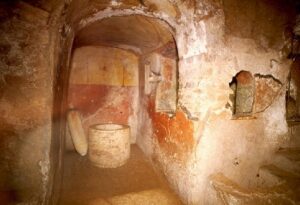
Fig. 2. View of a chamber well, Catacombs of Domitilla, Rome. The mouth of a stone well sits in a small arched chamber. Next to it a large cylindrical shaped amphora leans against the wall. The walls are red and orange and a decorative motif is painted on the back wall. The well was used to supply water for the refrigeria (DAPICS n. 0536).
The hypogaea of the Flavii, its walls richly frescoed with rural themes, was begun between the end of the second century and the beginning of the third. It seems to have been used by Christians from the time it was enlarged in the second half of the third century, when the entrance to the catacomb was modified with the construction of a room on one side with a well to which water was supplied by a pipe from a small cistern, and, on the opposite side, an enclosure with two benches, providing mourners with all the elements needed to perform the ritual of the funerary meal or refrigerium. The whole area became part of the larger catacomb network in the early fourth century.
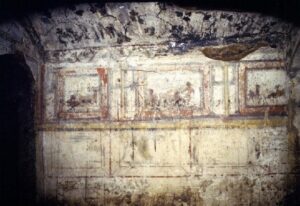
Fig. 3. Pastoral scenes in the Catacomb of Domitilla, Rome. At center, two winged putti tend their flock of sheep. Animals are depicted in the two side panels. The cubiculum was discovered in 1881 by G. B. de Rossi; the name Ampliatus was inscribed on a marble fragment found in the crypt (DAPICS n. 2808).
The Ampliatus hypogaeum dated from a period of about the late second or early third century. It had a simple plan: a stairway leading down to two double chambers on either side of a landing. Pergola judged that the decoration of the chambers had been carried out in four phases, with the first two phases dated to the beginning and second half of the third century, to which period are also dated two epitaphs that give the site its modern name.[xiii]
Testini suggested that the Ampliatus hypogaeum began as a large space belonging to a wealthy family of imperial freedmen which was subdivided at a later time to accommodate more family members. The decoration is noteworthy for the use of trompe l'oeil architectonic ornamentation - false doors flanked by insubstantial pilasters, panels, and framed scenes evocative of the illusionistic Pompeian Second Style of wall painting.[xiv] This burial crypt was probably incorporated into the catacomb during the second half of the third century in the course of the expansion of the Domitilla gallery network.[xv]
The hypogaeum of the "Flavii Aurelii," dating to the late second century, differs from other early units in the Domitilla catacomb in that it may have been of Christian origin from its very beginning. Philippe Pergola has recognized it as a fusion of two nuclei, what he labeled as region 5, which is slightly earlier than the second nucleus, labeled as region 6. The former he sees "exploited in an intense fashion" to accommodate as many burials as possible. Both the epigraphic evidence and heavy usage, as well as the absence of such features as arcosolia and painted surfaces, raises the possibility that this region of limited extent was a communal place of interment for individuals from different families. The early Christian martyrs commemorated in the Domitilla cemetery, the Roman soldiers Nereus and Achilleus, likely were buried in this type of environment, and the veneration of their tombs was a factor in the expansion of the burial grounds in the fourth century CE.[xvi] At the end of the fourth century, the Basilica of Saints Nereus and Achilleus was erected over their graves.[xvii]
"The Good Shepherd" hypogean complex, named after the "Chamber of the Good Shepherd" at the foot of the second ramp of the great staircase, dates from the early third century on, and is the most extensive in the catacomb. Originally private, the Good Shepherd complex lost its exclusive aspect when all of the early zones were absorbed into the greater communal cemetery in the early part of the fourth century. It was developed on two different levels, and was comprised of large, sumptuously decorated chambers and side galleries.[xviii]
The paintings in the upper part of the "Chamber of the Good Shepherd" were executed at the beginning of the third century, and those in the lower section at the beginning of the fourth. Still preserved in the passages of this region (and in a stairwell) are images painted on the closures of loculi. On a chamber vault is a rare example in Late Roman painting of David holding his slingshot[xix]. This image, dating to the later part of the fourth century, testifies to the use of Hebrew Bible themes by Christians well after the Constantinian era.
The "Hypogeum of the Sarcophagi" in the Domitilla complex may have originated as the underground chamber of a mid-third century mausoleum. Sarcophagi of "exclusively pagan character" were found there in situ and dated to that time. Subsequent construction of the semi-hypogean basilica to Saints Nereus and Achilleus, perhaps at the end of the fourth century CE, however, has badly damaged this site.[xx]
At the beginning of the third century, one of the Christian communities in Rome, using collective assets, established the first documented communal cemetery under church title in an area between the via Appia and via Ardeatina that had been used for burial since the period of the Republic.[xxi] Pope Zephyrinus delegated the administration of the burial grounds to the deacon Callixtus.
A strong adversary of this deacon, the theologian Hippolytus, held that Callixtus was a former slave, a failed banker who had run away from his creditors, a reputed disturber of the peace during services in a synagogue, and an escaped convict.[xxii] Nevertheless, Callixtus succeeded Zephyrinus as pope. During his papacy (217-222), he is said to have enlarged the cemetery which his predecessor had entrusted to his care, in which the Crypt of the Popes, the most revered site in all of the Roman catacombs, became the burial-place for nine of the bishops of Rome of the third and fourth centuries. Although the cemetery would carry the name of Callixtus, neither of the two popes who established and developed the catacomb was buried in it. A seventh century record locates the tomb of Zephyrinus in a site above the catacomb, possibly a mausoleum or other type of sepulcher near the entrance to the underground Crypt of the Popes.[xxiii] Callixtus himself was buried in the Cemetery of Calepodius on the via Aurelia. This cemetery, containing a large circular mausoleum from about 80-40 BCE, was exploited from Roman Republican times to at least the fourth century.[xxiv] The presence in this site of hypogea and monumental mausoleums, some pagan and some Christian, indicates that this was a necropolis where the acquisition of burial plots was unrestricted for much or all of the time it was in use.
The catacomb of Monteverde, the first Jewish cemetery to be identified in modern times, has been considered to be the oldest of the Jewish catacombs in Rome. So much of it has been destroyed, however, that its true extent and chronological development may never be certain. The conclusions about its age have been drawn from a number of its structural features, such as the types of tombs and a lack of painted chambers, as well as considerations about its location on the right bank of the Tiber and a Jewish clientele. A large number of artifacts survive, such as inscriptions, stamped tiles, and other small goods, as well as drawings and descriptions, but this material alone cannot create a full chronology of the site.[xxv] Nonetheless, from the existing documentation, archaeologist Nikolaus Muller's observation that the site "appears to be formed of two parts, completely different architectonically," points to different phases of excavation and possibly growth from pre-existing hypogea, although Muller himself was not convinced of this possibility because he had found only one access point into the underground site, which seemed to exist at just one level.[xxvi]
In the course of Fr. Frey's research in ancient Jewish inscriptions, he made the first detailed study of the brick stamps and epigraphy from the Jewish catacombs of Rome.[xxvii] From his analysis of 231 brick stamps, Frey concluded there had been activity in the Jewish catacombs from the late first or early second century CE to the fourth century.[xxviii] The Monteverde catacomb offered the greatest number of stamps and seemed to encompass the broadest time-span. A number of the stamps were identified as from the first century CE with a few, apparently, even earlier.[xxix] This evidence led Frey to suggest that the Monteverde cemetery antedated the other Jewish catacombs in Rome, with an intense use in the second and third centuries.
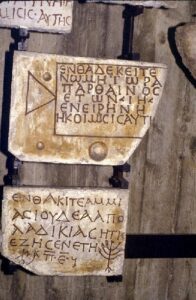
Fig. 7. Various inscriptions from the Catacomb of Monteverde, now in the Vatican Museums. TOP: (Frey #381, Noy #191) In Greek: "Here lies Nometora, a virgin, aged 18 years. In peace her sleep." BOTTOM: (Frey# 296, Noy #183) In Greek and Hebrew: "Her lies Ammias, a Jewess from Laodicea, who lived 85 years. Peace." With a menorah bottom right (DAPICS n. 1936).
The origins of the Monteverde catacomb may, indeed, antedate the documentation found in the areas possible to be explored through the early twentieth century, but in David Noy's compilation of Jewish inscriptions from Rome, the Monteverde epitaphs are dated almost without exception to the third and fourth centuries CE. Noy's conclusion corroborates with the opinions of other catacomb scholars, including Leonard Rutgers and Fr. Umberto M. Fasola (both cited by Noy), that the Monteverde brick stamps are mainly from the third century, with some from the fourth.[xxx] This information has been newly reiterated in a comprehensive report on the Monteverde catacomb in 2013.[xxxi]
Similar problems of inaccessibility have frustrated the study and documentation of other Jewish catacombs, notably those of Vigna Cimarra and via Labicana, although Jessica Dello Russo demonstrated in 2001 that the former is extant.[xxxii] No material clues to date, however, can suggest a chronology anterior to that of Rome's other subterranean cemeteries, namely the third through early fifth centuries CE.
In the catacomb of the Vigna Randanini, two connected chambers, a cubiculum duplex, were ascribed by Frey to the late second or early third century CE. Testini pointed out, however, that they might not originally have been used by Jews and thus incorrectly date the time of Jewish occupancy of the site.[xxxiii] He saw the decorative motifs used in these chambers as belonging to a common Hellenistic tradition, with purely Jewish symbols, like the seven-branched candelabrum, the lulab, shofar, and "palms which allude to Palestine", not likely to have been included in the repertoire before the third century CE.[xxxiv] The central motif on the ceiling of the outermost chamber of the cubiculum duplex shows Victory crowning a youth, and in the center of the ceiling of the inner chamber is the figure of Fortuna, possibly as a Tyche, with a horn of plenty.[xxxvi] Despite their polytheistic attributes, these images did not prevent the chambers from being reused in a later period, probably by Jews, once this area was joined to the communal cemetery.[xxxvii]
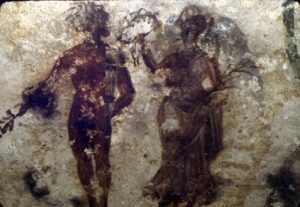
Fig. 8. Ceiling decorations of Cubiculum I, Catacomb of Randanini, Rome. It consists of a central circle with a concentric band about it, supported by designs at the sides and corners. Within this basic plan can be a variety of symbols, but the group or person within the central area represents inner heaven itself. The central figure is that of a winged Victory, holding a palm leaf in the left hand a crowning with her right hand a naked young man. The youth, actually already wearing a crown, holds some sort of spray in his right hand (DAPICS n. 1307).
In Rutgers' opinion, only the painted decoration of the so-called "Room IV", or "Menorah Chamber", can be considered "explicitly Jewish". Here there is a menorah in red above an arcosolium niche opposite the entrance, and on the ceiling are oval shapes that Rutgers' sees as ethrogim. The painting is far simpler and less accomplished than the decoration of other rooms in the catacomb that include anthropomorphic forms.[xxxv]
In 1919, archaeologist Roberto Paribeni supervised the earliest known excavations of two Jewish catacombs below the Villa Torlonia. He though they dated at the earliest to the second or early third century.[xxxviii] Fr. Umberto Fasola, who excavated in the site in 1973-1974, stated that the tombs of the two cemeteries, particularly those in the upper catacomb, suggested that it had served as a burial ground for Jews for at least two centuries. Recognizing the difficulty of fixing a precise chronology, Fasola used a "relative chronology" based on masonry techniques, and concluded that the entrance to the lower Torlonia catacomb was part of the original structure of the cemetery and that the entrance passageway went back "at least to the end of the second century CE" based on similar examples of the masonry style that date from that period, including the Vatican necropolis. Known as opus vittatum, it is a building technique where the bricks are laid in horizontal bands in which two strips of tuff blocks alternate with one of bricks. The whole surface is then covered in plaster. In the Villa Torlonia site, the opus vittatum begins at the external ramp and continues without interruption to the area of the light well over the descending passage into the galleries. Because of the continuity of the masonry and plaster work, Fasola asserted that this area had not been a previously-constructed monument that was then readapted, as found in other catacombs, but had been planned from the start as part of the communal cemetery complex.[xxxix]
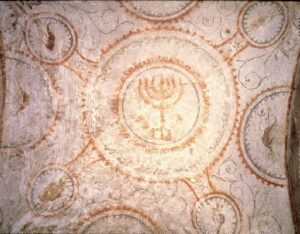
Fig. 9. A vault painting from the decorated cubiculum in the upper catacomb of Villa Torlonia features Jewish ritual objects: a menorah (seven branched lampstand), a shofar (horn), and ethrogs (citrons), while the grapevines, dolphins, and tridents were derived by both Jews and Christians from Greco-Roman iconography. (DAPICS n. 0683).
Fasola found the upper areas of the Villa Torlonia catacomb to be later, dating to the third century, not only because the brick stamps in this area established a terminus post quem, but also because he saw the style of painting in the upper catacomb, especially that in the vault of the only decorated chamber in the site as supporting a mid-third century date, which Testini also favored.[xl] A more recent analysis of the paintings by Leonard Rutgers, however, has suggested a fourth century date.[xli]
Father Antonio Ferrua, SJ, a specialist in early Christian epigraphy, observed that while some inscriptions from the Villa Torlonia catacombs could date to the third century, a "greater part (came from) the fourth century or even later". Testini likewise supports this view that the epigraphy in the Jewish catacombs contains "characters prevalent in the fourth and fifth centuries".[xlii]
As may be concluded from this sampling of the diversity of scholarly opinion, fixing precise dates for the catacombs is not easy, and so far, it seems, the chronology of the Jewish catacombs of Rome can only be established in general terms.[xliii]
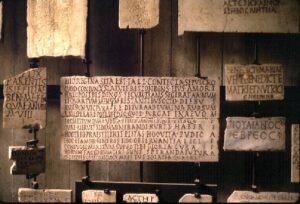
Fig. 10. Detail of various inscriptions from the Catacomb of Monteverde, now at the Lateran Museum. UPPER LEFT: (Frey #30*, Noy #122) In Latin: "(…)Felix, the parents set up (this stone) to their daughter Isia, in grateful memory. She (lived) 9 years, 8 months." (This inscription is possibly pagan, but found at Monteverde) CENTER: (Frey #476, Noy #103) In Latin: "Here lies Regina, covered by such a tomb, her husband set up as fitting to his love. After twice ten years she spent with him one year, four months and eight days more. She will love again, return to the light again, for she can hope that she will rise to the life promised, as is our true faith, to the worthy and pious, in that she deserved to posses an abode in the hallowed land. This your piety has assured you, this your chaste life, this your love for you people, this your observance of the Law, your devotion to your wedlock, the glory of which was dear to you. For all these deeds your hope of the future is assured. In this your sorrowing husband seeks his comfort. " LOWER RIGHT: (Frey #354, Noy #44) In Greek: "Julianus, a Hebrew" (DAPICS n. 1920).
A related issue concerns the numbers of the dead the catacombs contain. In an effort to estimate the number of Christian and Jewish burials in Rome during the Late Imperial Period, scholars have counted and studied the inscriptions. This approach, however, is conditioned by the lack of documentation for many pieces and disappearance of many others. Testini estimated that more than 20,000 Christian epitaphs had been recovered by 1966, the year he published his survey of the catacombs of Rome. Silvagni and Ferrua, the compilers of the ICUR, published nine volumes of the series by 1985, and the number still continues to grow as a result of subsequent finds.[xliv] From the six known Jewish catacombs, about 537 inscriptions have been recovered to date. Noy's 1995 corpus of Jewish inscriptions from Rome indexes 529 from the Monteverde, Vigna Randanini, Villa Torlonia, Vigna Cimarra, and Via Labicana/Vigna Apolloni sites. He included seven other inscriptions from the catacombs of Monteverde and Vigna Randanini as possibly Jewish, although they began with the Latin formula D.M. or Dis Manibus, a phrase common on pagan tombstones as a protective invocation to the gods or spirits of the underworld. Noy noted that the formula was also found in the Christian catacombs, but its appearance in that context probably indicated that the phrase had been inscribed on a tomb slab in the Roman workshop before the stone was bought by a client.[xlv] Similarly, Rutgers thought that in a Jewish context, a stone carrying that formula might be intrusive to the area, recycled in a new epitaph, or simply an example of scrap employed in a tomb closure or in repair work carried out at some point within the site. He pointed out that D. M. never appears in the graffiti or painted epitaphs and that "typically Jewish information" had not been found in the D. M. inscriptions.[xlvi]
In addition to the problems in estimating the physical extent of the catacombs, it is also difficult to determine the ownership of underground burial sites (hypogea) of limited extent and whether or not all of their occupants subscribed to the same religious belief system.[xlvii] The fifty or so Christian and Jewish catacombs are believed by many to have served particular congregations. Yet a number of other funerary hypogea seem to have been commissioned and used on an intimate scale by affluent families or groups whose members might not have all converted to Christianity. Isolated Jewish tombs have been identified in the Monteverde area at some distance from the catacomb and also in the vicinity of the catacombs of San Sebastiano; moreover, Jews almost certainly buried sub divo in many sites.[xlviii]
[i] L. V. Rutgers, The Jews in Late Ancient Rome: Evidence of Cultural Interaction in the Roman Diaspora (Leiden-Boston: Brill, 1995), p. 67.
[ii] D. Noy dates most of the inscriptions from the Roman Jewish catacombs to the third and fourth centuries CE (Jewish Inscriptions of Western Europe 2: The City of Rome [JIWE 2]). However, he notes that n. 401, observed by Marucchi at the entrance to the Vigna Randanini catacomb, may suggest occasional site reuse; see op. cit. pp. 330-331. For further discussion, refer to D. Noy, "Where Were the Diaspora Jews Buried?" in M. Goodman (ed.), Jews in a Greco-Roman World (Oxford-New York: Clarendon Press, 1998), p. 79, note 24, and Rutgers, The Jews in Late Ancient Rome, p. 67.
[iii] According to Noy ("Diaspora Jews", p. 79, note 25), by the early first century CE, the population of Jews in Rome may well have reached 30,000.
[iv] Rutgers, Jews in Late Ancient Rome, p. 96.
[v] Rutgers, Jews in Late Ancient Rome, p. 52.
[vi] Other Italian regions had suitable geology for underground burial caverns, especially Apulia, Etruria, Latium, Umbria, Sardinia, and Sicily.
[vii]
According to the fourth-century Christian bishop and historian Eusebius, the cemeteries confiscated by Emperor Valerian during his persecutions were later restored to the bishops by Emperor Gallienus (253-268). This suggests that Christian cemeteries were already established during this period, as documented in Eusebius, Hist. Eccl. 7, 13.
[viii] U. M. Fasola, The Catacombs of Domitilla and the Basilica of the Martyrs Nereus and Achilleus (Rome, 1974).
[ix] Eusebius, Hist. Eccl. 3:18.
[x] Fasola, Domitilla, p. 4. See also E. M. Smallwood, The Jews Under Roman Rule (Leiden: E. J. Brill, 1976), pp. 381-383, for Domitilla's possible Jewish connection.
[xi] P. Pergola, Le catacombe romane: storia e topografia (Rome: Carocci, 1998), pp. 211-216.
[xii] De Rossi appears to have erroneously identified the hypogeum of the Flavii as the burial place of Christian members of the Flavia Domitilla family; see P. Pergola, Catacombe romane, p. 211.
[xiii] Pergola, Catacombe romane, p. 212.
[xiv] P. Testini, Archeologia cristiana, 2nd ed. (Bari: Edipuglia, 1980), pp. 202-203.
[xv] P. Pergola, "Coemeterium Domitillae: le labyrinthe de la via Ardeatina," in Les dossiers de l'archeologie 18 (1976), p. 90.
[xvi] Pergola, "Coemeterium," p. 94.
[xvii] U. M. Fasola, The Catacombs of Domitilla and the Basilica of the Martyrs Nereus and Achilleus (Rome, 1974), pp. 12-30; P. Testini, Le catacombe e gli antichi cimiteri cristiani in Roma (Bologna: Cappelli Editori, 1966), pp. 202-220; P. Pergola, "Coemeterium Domitillae: le labyrinthe de la via Ardeatina," in Les dossiers de l'archeologie 18 (1976), pp. 86-99.
[xviii] Approximately ten slaves of freedmen were interred in the side galleries; see P. Pergola, "Coemeterium,"pp. 92-93.
[xix] Pergola,"Coemeterium," pp. 92-93.
[xx] Pergola, "Coemeterium," pp. 93-94.
[xxi] P. Pergola, Catacombe romane, pp. 195-202. De Rossi also proposed that the site could have served as a burial place for members of the noble Cecilii family; see Roma Sotterranea 1 (Rome: Chromo-litografia Pontificia, 1865), p. 309 ff.
[xxii] The catacomb of S. Ippolito might derive its name from the historical figure Hippolytus. The synagogue episode, documented in the ninth book of the Philosophumena, possibly written by Hippolytus himself, could have been distorted due to Hippolytus' unfavorable feelings toward Callixtus. For more details, refer to de Rossi, Bullettino di Archeologia Cristiana 4:1, pp. 1-13, and 4:2, pp. 17-33; J. S. Northcote and W. R. Brownlow, Roma Sotterranea: or Some Account of the Roman Catacombs especially of the Cemetery of San Callisto (London: Longmans, 1879), pp. 497-505.
[xxiii] Testini, Archeologia cristiana, pp. 209-210. The burial of Zephyrinus is documented in the Notitia ecclesiarum urbis Romae, composed around the time of Pope Honorius; see Testini, Cimiteri cristiani, p. 65.
[xxiv] Testini, Cimiteri cristiani, pp. 67-69.
[xxv] Noy, JIWE 2, p. 4.
[xxvi] N. Muller, "Il cimitero degli antichi Ebrei posto sulla Via Portuense," in Dissertazioni della Pontificia Accademia Romana di Archeologia 2.12 (1915), p. 225. Muller identified areas of the catacomb nearest to the single entrance stairway as notably wide (3 meters), characterizing them as "grottoes" and "recessed annexes" not observed in other parts of the site.
[xxvii] CIJ 1, pp. 9-11 (Torlonia); p. 55 (Randanini); pp. 212-227 (Monteverde).
[xxviii] H. J. Leon suggested a potential initiation date of the first century BCE for the Monteverde cemetery, marking the earliest proposed date for any Jewish cemetery in Rome; see Leon, Jews of Ancient Rome, p. 66.
[xxix] JIWE 2, pp. 3-5, though Noy concedes that some inscriptions might be earlier.
[xxx] Noy, JIWE 2, p. 4.
[xxxi] D. Rossi and M. Di Mento, eds., La catacomba ebraica di Monteverde: vecchie dati e nuove ricerche (Rome: Rotoform, 2013).
[xxxii] J. Dello Russo, "The Jewish Catacomb of the Vigna Cimarra", in Roma Subterranea Judaica 3 (2010).
[xxxiii] E. R. Goodenough, Jewish Symbols in the Greco-Roman Period, vol. 3 (New York: Pantheon Books, 1953), vol. 2, pp. 14-33; figs. 737-762.
[xxxiv] Testini, Archeologia cristiana, p. 325.
[xxxv] Rutgers, in Jews in Late Ancient Rome, notes on pp. 73-74 that the ceiling in Room III, also known as the "Chamber of the Palms," was removed in antiquity to create additional tombs higher up on the walls.
[xxxvi] Leon, Jews of Ancient Rome, pl. 10, figs. 14-15; pl. 11, fig. 16.
[xxxvii] The small catacombs of Via Labicana (or Vigna Apolloni) and Vigna Cimarra were identified as Jewish due to the motifs inscribed or painted on some artifacts recovered from these sites before they became inaccessible. Rutgers and Noy posit that these catacombs likely date to a similar period as other known Jewish sites; see Rutgers, Jews in Late Ancient Rome, pp. 92-93; 97-98, and Jewish Inscriptions of Western Europe 2 (JIWE 2), pp. 332, 338.
[xxxviii] R. Paribeni, "Catacomba giudaica sulla via Nomentana," in Notizie degli Scavi d'Antichità (1920), p. 154.
[xxxix] U. M. Fasola, "Le due Catacombe di Villa Torlonia," in Rivista di Archeologia Cristiana, 52 (1976), pp. 41, 62, n. 42. For comparable chronological information regarding the Vatican necropolis, refer to Testini, Cimiteri cristiani, p. 72. According to A. G. McKay, Houses, Villas, and Palaces in the Roman World (London: Thames and Hudson, 1975), p. 90, opus vittatum seems to have been predominantly used between 150 and 450 CE, allowing for a wide range in dating its use in construction. However, a more recent report suggesting the continued use of this technique beyond that period prevents it from being considered a definitive chronological indicator; see R. Marta, Tecnica costruttiva romana (Rome: Kappa, 1991), pp. 34-35.
[xl] Fasola, Torlonia, p. 62; Testini, Archeologia cristiana, p. 325.
[xli] L. V. Rutgers, "Archaeological Evidence for the Interaction of Jews and Non-Jews in Late Antiquity," American Journal of Archaeology 96 (1992), p. 107. See also Jewish Inscriptions of Western Europe 2 (JIWE 2), p. 343.
[xlii] A. Ferrua, "Sulla tomba dei Cristiani e su quella degli Ebrei," in La Civilta Cattolica 87:4 (1936), pp. 309-310; Testini, Archeologia cristiana, p. 325, note 4. Noy, in Jewish Inscriptions of Western Europe 2 [JIWE 2], pp. 347-414, also dates the Torlonia inscriptions to the third and fourth centuries.
[xliii] In a publication on the internet, "The Jewish Catacombs of Rome: A Study of the Differences Between the Monteverde and Vigna Randanini Catacombs," David Noy has indicated that, upon analyzing the inscriptions in the two catacombs, he would date the Vigna Randanini inscriptions "primarily to the late second and third centuries" and the Monteverde inscriptions "primarily to the fourth."
[xliv] Testini, Cimiteri cristiani, pp. 193-194; A. Silvagni, A. Ferrua, D. Mazzoleni, and C. Carletti, eds., Inscriptiones Christianae Urbis Romae septimo saeculo antiquiores (Vatican City: Pontificio Istituto di archeologia cristiana, 1922-), vols. 1-11.
[xlv] For the questionable inscriptions, JIWE 2, Appendix 2, pp. 489-494.
[xlvi] Rutgers, Jews in Late Ancient Rome, Appendix, pp. 269-272.
[xlvii] De Rossi, Roma Sotterranea 1, pp. 87 ff., observed similarities between Christian hypogea and those of polytheists and Jews. L. Morpurgo, in "Anzio, sepolcreto sotterraneo pagano," in Notizie degli Scavi d'Antichità V-VI (1944-45), p. 165, commented on the non-Christian origins of cemeteries like that of S. Gennaro at Naples, S. Giovanni in Syracuse (Sicily), and S. Antioco in Sulcis (Sardinia), where four Punic hypogea were repurposed. On this point, see also M. Marinone, L. Pani Ermini, and R. Giordani, Dossiers de l'archéologie 19 (1976), p. 80, and consult the map in op. cit. 18 (1976), pp. 10-11.
[xlviii] Frey, CIJ 1, pp. lxi-lxii.

